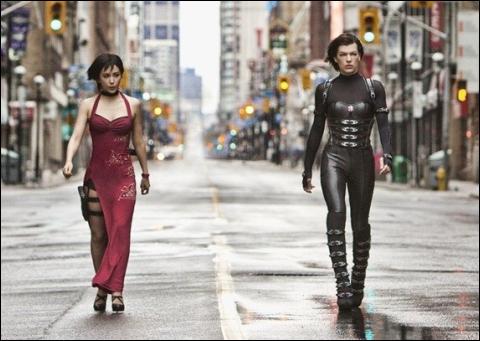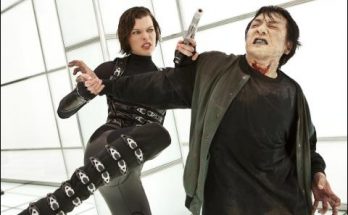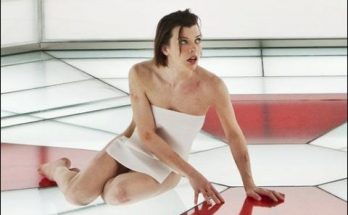Through four previous outings, the Resident Evil saga has taken audiences around the world and deep inside the mysterious Umbrella Corporation, but never before on such a vast scale. “Resident Evil has always been a global franchise,” says Anderson. “I don’t mean just in the way it’s shot, but also in the locations. In the first movie, it was the claustrophobia of the Hive; in the second, the nighttime streets of Raccoon City. The third movie moved to the desert and the fourth movie had post-apocalyptic Los Angeles burning to a crisp. This time we’ve made what is effectively a road movie, because we go from one country to another to another in a novel way.”
The film’s script called for 74 sets as the action swiftly shifts from North America to Japan to Moscow to Kamchatka in northernmost Russia, all shot in Toronto on studio sets and location. “We used some astonishing visual effects to create the illusion that we were traveling the world,” says Anderson. “Moscow and Tokyo would have been very difficult locations to shoot in. Even if we had gone to Japan, we would never have been able to close down the center of Shibuya and have that kind of carnage and devastation, so we built a huge chunk of the district on a back lot. We did send a unit to Moscow and shut down parts of Red Square for two days in order to create background plates for a very detailed recreation, including the Gum Store, which is the Harrods of Moscow.”
Production designer Kevin Phipps conceptualized each of the movie’s disparate settings, both replicated and invented. “There are tons of fantastic visual contrasts in the film, which made it very exciting to work on,” says Phipps. “The world of Resident Evil is like no other. We were designing for an imagined world, the high-tech futuristic world of the Umbrella Corporation, but fitting it into the already existing world. It was a very broad canvas.
“When Paul wrote the scene set in Red Square, we had to figure out the most visually interesting yet economical way to shoot it,” he adds. “It required a very fine balance of physical and virtual sets. We were meticulous in the detailing. I found a lot of joy in the interface between reality and illusion.”
Phipps’ most compelling innovation is the interior of the Umbrella Corporation’s ingeniously hidden fortress. To represent the corporation’s nerve center, he designed a world made out of glass: corridors, interrogation rooms and a control center, all filled with light and stretching into chilly infinity. “We ended up designing a modular system of floor panels and wall panels, which were repurposed for our different looks,” he says. “It turned out to be more of a technical challenge than we anticipated. Quite a bit of research and development went into to coming up with a coherent design philosophy for doors and panels, as well as finding the best way to light the sets. There’s a lot of super-high-speed photography, as well as 3D in the film. When you are shooting at 216 frames a second, you need a lot of light.”
For his third feature film in 3D, Anderson and his longtime collaborator, director of photography Glen MacPherson, utilized the most up-to-date equipment, some of it specifically developed for Resident Evil: Retribution. “When we made Resident Evil : Afterlife, we used what was then the leading edge of technology,” Anderson says. “It has evolved enormously since then and Glen brought his own ingenuity to bear.
“Glen was tired of me complaining that I couldn’t do certain things with 3-D rigs, so he built one for me,” Anderson continues. “I was frustrated because I could never use a big wide-angle lens. And you had to bring in a different camera if you wanted to do slow motion. The new rigs are smaller and more mobile than the rigs we used on the last film, so we could do more Steadicam work. They are built to my specifications for the way I like to shoot, and as a result the camera work on this movie is the most adventurous I’ve ever shot in 3D.”
The rigs MacPherson and second-unit director of photography Vern Nobles put together gave the photography team freedom that was previously unprecedented in the 3D realm. “For the first time, we had a camera rig that we could stick on a car without tethering it to any recording towers,” says MacPherson. “We could shoot in slow motion without having a whole bunch of equipment following us. And all of the cameras had the flexibility to shoot at both high and low speeds. We are able to take a whole different approach to shooting.”
With audiences more used to 3D, Anderson felt freer in other ways as well. “I think we can cut faster. We can do more hand-held and tolerate more camera shake, which we stayed away from just two years ago. So I think the film will have a much more kinetic feel than you’re used to seeing in a 3D film. Hopefully people’s eyes won’t explode. But if they do, they’ll be having a good time, because we’ve put some pretty amazing stuff on screen on this film.”
And the director finally got his yearned-for wide-angle lenses. “We like to say that the ‘W.S.’ in his name stands for ‘wide shot,'” says MacPherson. “Paul rarely does over-shoulder or master shots. We usually push the camera as far back as we can into a corner and shoot from crazy angles. We have environments in this movie that seem to go on and on forever.”
Next Page: Biggest Visual Effects Ever Created
Views: 99



